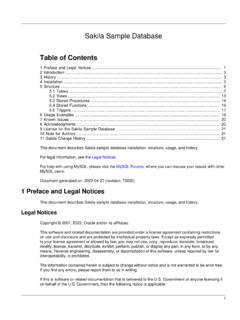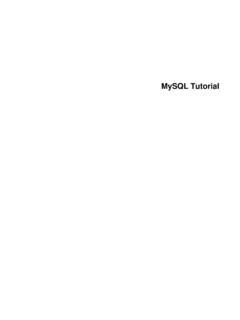Transcription of Introduction to Structured Query Language (SQL)
1 IntroductIonWe have learnt about Relational Database Management System (RDBMS) and purpose in the previous chapter. There are many RDBMS such as mysql , Microsoft SQL Server, PostgreSQL, oracle , etc. that allow us to create a database consisting of relations and to link one or more relations for efficient querying to store, retrieve and manipulate data on that database. In this chapter, we will learn how to create, populate and Query database using this chapter Introduction Structured Query Language (SQL) Data Types and Constraints in mysql SQL for Data Definition SQL for Data Manipulation SQL for Data Query Data Updation and DeletionIntroduction to Structured Query Language (SQL) Chapter 8 The most important motivation for the research work that resulted in the relational model was the objective of providing a sharp and clear boundary between the logical and physical aspects of database management.
2 E. F. CoddChap 14319-Jul-19 3:45:57 PM2022-23144 INFORMATICS PRACTICES CLASS Structured Query Language (SQL) One has to write application programs to access data in case of a file system. However, for database management systems there are special kind of programming languages called Query Language that can be used to access data from the database. The Structured Query Language (SQL) is the most popular Query Language used by major relational database management systems such as mysql , oracle , SQL Server, is easy to learn as the statements comprise of descriptive English words and are not case sensitive. We can create and interact with a database using SQL in an efficient and easy way. The benefit with SQL is that we don t have to specify how to get the data from the database.
3 Rather, we simply specify what is to be retrieved, and SQL does the rest. Although called a Query Language , SQL can do much more besides querying. SQL provides statements for defining the structure of the data, manipulating data in the database, declare constraints and retrieve data from the database in various ways, depending on our this chapter, we will learn how to create a database using mysql as the RDBMS software. We will create a database called StudentAttendance (Figure ) that we had identified in the previous chapter. We will also learn how to populate database with data, manipulate data in that and retrieve data from the database through SQL Installing MySQLMySQL is an open source RDBMS software which can be easily downloaded from the official website After installing mysql , start mysql service.
4 The appearance of mysql > prompt (Figure ) means that mysql is ready for us to enter SQL rules to follow while writing SQL statements in mysql : SQL is case insensitive. That means name and NAME are same for SQL. Always end SQL statements with a semicolon (;). To enter multiline SQL statements, we don t write ; after the first line. We put enter to continue on next line. The prompt mysql > then changes to -> , Activity LibreOffice Base and compare it with MySQLChap 14419-Jul-19 3:45:57 PM2022-23 Introduction to Structured Query Language (SQL)145indicating that statement is continued to the next line. After the last line, put ; and press enter. data typeS and conStraIntS In MySQLWe know that a database consists of one or more relations and each relation (table) is made up of attributes (column).
5 Each attribute has a data type. We can also specify constraints for each attribute of a Data type of AttributeData type indicates the type of data value that an attribute can have. The data type of an attribute decides the operations that can be performed on the data of that attribute. For example, arithmetic operations can be performed on numeric data but not on character data. Commonly used data types in mysql are numeric types, date and time types, and string (character and byte) types as shown in Table : mysql ShellThink and ReflectCan you think of an attribute for which fixed length string is suitable?Table Commonly used data types in MySQLData typeDescriptionCHAR(n)Specifies character type data of length n where n could be any value from 0 to 255. CHAR is of fixed length, means, declaring CHAR (10) implies to reserve spaces for 10 characters.
6 If data does not have 10 characters (for example, city has four characters), mysql fills the remaining 6 characters with spaces padded on the (n)Specifies character type data of length n where n could be any value from 0 to 65535. But unlike CHAR, VARCHAR is a variable-length data type. That is, declaring VARCHAR (30) means a maximum of 30 characters can be stored but the actual allocated bytes will depend on the length of entered string. So city in VARCHAR (30) will occupy the space needed to store 4 characters are the other data types supported in mysql ? Are there other variants of integer and float data type?Chap 14519-Jul-19 3:45:57 PM2022-23146 InformatIcs PractIces class XIThink and ReflectWhich two constraints when applied together will produce a Primary Key constraint?INTINT specifies an integer value.
7 Each INT value occupies 4 bytes of storage. The range of values allowed in integer type are -2147483648 to 2147483647. For values larger than that, we have to use BIGINT, which occupies 8 numbers with decimal points. Each FLOAT value occupies 4 DATE type is used for dates in 'YYYY-MM-DD' format. YYYY is the 4 digit year, MM is the 2 digit month and DD is the 2 digit date. The supported range is '1000-01-01' to '9999-12-31'. ConstraintsConstraints are certain types of restrictions on the data values that an attribute can have. They are used to ensure the accuracy and reliability of data. However, it is not mandatory to define constraint for each attribute of a table. Table lists various SQL Commonly used SQL ConstraintsConstraintDescriptionNOT NULLE nsures that a column cannot have NULL values where NULL means missing/unknown/not applicable that all the values in a column are default value specified for the column if no value is KEYThe column which can uniquely identify each row or record in a KEYThe column which refers to value of an attribute defined as primary key in another SQL for data defInItIonSQL provides commands for defining the relation schemas, modifying relation schemas and deleting relations.
8 These are called Data Definition Language (DDL) through which the set of relations are specified, including their schema, data type for each attribute, the constraints as well as the security and access related definition starts with the create statement. This statement is used to create a database and its tables (relations). Before creating a database, we should be clear about the number of tables in the database, the columns (attributes) in each table along with the data type of each column. This is how we decide the relation CREATE DatabaseTo create a database, we use the CREATE DATABASE statement as shown in the following syntax:CREATE DATABASE databasename;Chap 14619-Jul-19 3:45:57 PM2022-23 Introduction to Structured Query Language (SQL)147To create a database called StudentAttendance, we will type following command at mysql > CREATE DATABASE StudentAttendance; Query OK, 1 row affected ( sec)Note: In LINUX environment, names for database and tables are case-sensitive whereas in WINDOWS, there is no such differentiation.
9 However, as a good practice, it is suggested to write database or table name in the same letter cases that were used at the time of their DBMS can manage multiple databases on one computer. Therefore, we need to select the database that we want to use. Once the database is selected, we can proceed with creating tables or querying data. Write the following SQL statement for using the database: mysql > USE StudentAttendance;Database changedInitially, the created database is empty. It can be checked by using the Show tables command that lists names of all the tables within a database. mysql > SHOW TABLES;Empty set ( sec) CREATE TableAfter creating database StudentAttendance, we need to define relations (create tables) in this database and specify attributes for each relation along with data types for each attribute.
10 This is done using the CREATE TABLE statement. Syntax:CREATE TABLE tablename(attributename1 datatype constraint,attributename2 datatype constraint,:attributenameN datatype constraint);It is important to observe the following points with respect to the Create Table statement: N is the degree of the relation, means there are N columns in the table. Attribute name specifies the name of the column in the table. Datatype specifies the type of data that an attribute can hold. Constraint indicates the restrictions imposed on the values of an attribute. By default, each attribute can take NULL values except for the primary the statement show database;. Does it show the name of StudentAttendance database?ShowChap 14719-Jul-19 3:45:57 PM2022-23148 INFORMATICS PRACTICES CLASS XILet us identify data types of the attributes of table STUDENT along with their constraint, if any.












